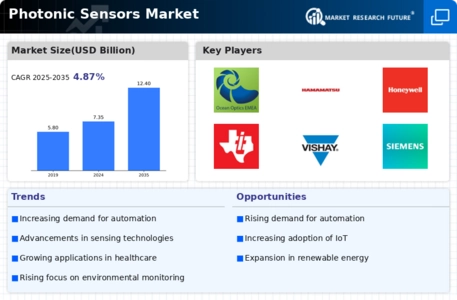Top Industry Leaders in the Photonic Sensors Market

Competitive Landscape of the Photonic Sensors Market:
The photonic sensors market witnessing robust growth fueled by surging demand for accurate and reliable sensing solutions across diverse industries. This thriving field boasts a dynamic competitive landscape, characterized by established players, nimble startups, and a constant flow of technological advancements. Navigating this terrain requires a keen understanding of the strategies employed by key players, factors influencing market share, and the emergence of disruptive forces.
Some of the Photonic Sensors companies listed below:
- Toshiba Corporation
- Prime Photonics
- Samsung Electronics Co. Ltd.
- Banpil Photonies Inc
- Intevac Inc..
- Mitsubishi Electric Corporation
- General Electric Company
- NP Photonics Inc.
- Oxensis
Strategies Adopted By key Players:
- Portfolio Diversification: Leading players are expanding their portfolios beyond core offerings to cater to a wider range of applications. This involves venturing into new sensor types, integrating different technologies, and developing customized solutions for specific industry needs. Examples include TE Connectivity's focus on LiDAR sensors for autonomous vehicles and Infineon's expansion into biophotonics.
- Vertical Integration: Integrating manufacturing processes across the value chain enables companies to optimize production costs, improve quality control, and gain greater control over supply chains. This strategy is particularly relevant for high-precision sensors and components. ON Semiconductor's acquisition of SensL, a leading CMOS image sensor developer, exemplifies this trend.
- Partnerships and Collaborations: To bridge technological gaps and accelerate innovation, strategic partnerships are becoming increasingly common. Collaborations with research institutions, universities, and startups are fostering rapid development of new materials, fabrication techniques, and sensor applications. For instance, II-VI Incorporated partnered with the University of Cambridge to advance research on GaN-based ultraviolet sensors.
- Investments in R&D: Continuous research and development remain crucial for maintaining a competitive edge. Companies are pouring resources into miniaturization, enhancing sensitivity and accuracy, and exploring novel materials like graphene and metamaterials. Key players like Hamamatsu Photonics and STMicroelectronics have dedicated R&D centers focused on photonic sensor innovation.
Factors influencing market share analysis:
- Product Portfolio Breadth and Depth: Companies with a diverse range of sensor types catering to various applications hold a distinct advantage. Offering sensors compatible with different wavelengths, resolutions, and sensitivity levels enables addressing varied customer needs. For instance, ams AG's diverse portfolio of optical sensors for consumer electronics, medical devices, and industrial applications contributes to their strong market position.
- Technological Expertise and Innovation: Possessing cutting-edge technology and a solid track record of innovation attracts customers seeking high-performance sensors. Players demonstrating advancements in miniaturization, integration with other technologies, and improved sensitivity stand out in the competitive landscape. Festo, known for its innovative fiber optic sensors for industrial automation, is a prime example.
- Manufacturing Capabilities and Cost Efficiency: Efficient production processes and cost-competitive offerings are critical for securing market share, particularly in applications sensitive to price points. Companies like Himax Technologies and OmniVision Technologies, with established manufacturing capabilities and economies of scale, hold an edge in certain segments.
- Brand Reputation and Customer Relationships: Building a strong brand reputation for quality, reliability, and technical support helps cultivate customer loyalty and secure repeat business. Established players like Texas Instruments and Analog Devices benefit from their proven track record and extensive client base.
New and Emerging Companies:
The photonic sensor market is continuously attracting exciting startups entering with innovative solutions, often disrupting established players. Some noteworthy examples include:
- Senaptic Sensors: Developing biocompatible, implantable photonic sensors for real-time health monitoring.
- Vayyar Imaging: Pioneering radio frequency-based imaging technology with applications in security and healthcare.
- Rockley Photonics: Creating ultra-high-resolution 3D LiDAR sensors for autonomous vehicles and robotics.
These emerging companies, with their focus on niche applications and disruptive technologies, pose a challenge to established players and contribute to the dynamic nature of the market.
Latest Company Updates:
June 2023- Scientists at Sydney Nano and the School of Physics have created a new radar system using light waves that can detect vital signs without touching the patient. This system could potentially be used in intensive care units, nursing homes, for sleep apnea patients, or for infants with breathing issues. A key benefit of this non-contact approach is that it allows measuring vital signs remotely, removing the need for physical contact with patients. This improves patient comfort and also reduces the transmission of infections, making it very useful where infection prevention is important.
May 2023- MantiSpectra, a company based in Eindhoven, Netherlands that develops spectral sensor technology, has won the Hermes Award at the Hannover Messe trade fair in Germany for its ChipSense product. ChipSense is a spectral sensor integrated onto a single chip. MantiSpectra, which is supported by PhotonDelta, an organization focused on developing a photonics ecosystem, utilizes integrated photonics to substantially decrease the size and cost of sensors that analyse material properties. By lowering the costs and improving the efficiency and portability of these sensors, MantiSpectra aims to enable more automation and innovation in various applications. The company's miniaturized, inexpensive ChipSense spectral sensor makes material sensing technology more accessible for wider use.
May 2023- A research group headed by Professor Qing Guangyan from the Dalian Institute of Chemical Physics (DICP) of the Chinese Academy of Sciences recently created a sustainable, insoluble, and chiral photonic cellulose nanocrystal patch that can sense calcium ions (Ca2+) in sweat. This achievement is anticipated to open up opportunities for using sustainable cellulose sensors to monitor other metabolites like glucose, urea, and vitamins. It also establishes a foundation for digitally controlled hydrogel systems that could be used in environmental monitoring, membrane separation, and wearable technology.
